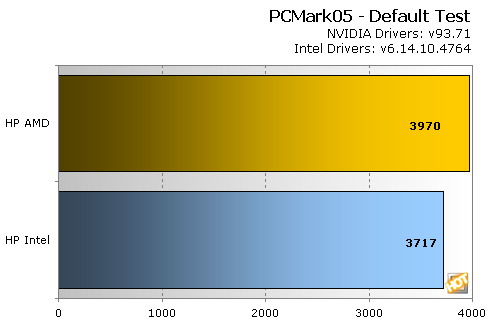

|
|
Performance Comparisons with PCMark05 v1.2.0
|
|
Details: www.futuremark.com/products/Pcmark05/
|
|

PCMark05
|
There are 11 system tests - each one is designed to represent a certain type of PC usage. By running these tests, PCMark05 stresses the components in a similar manner as they are stressed in normal home usage. The system test suite contains tests measuring different components of a PC and the results of the tests as well as the total score depend on all components. The system tests stress CPU, system bus, Memory and Graphics performance. The default test suite is the System Test Suite including tests combining the use of different components.
|

Looking at the results above, we see that the AMD platform narrowly edges out the Intel-based system for top honors. Though hardly a landslide victory, it's intresting to see the AMD platform outperforming Intel's Core 2 Duo.

|
|
Performance Comparisons with 3DMark05 v1.3.0
|
|
Details: www.futuremark.com/products/3dmark05/
|
|

3DMark05
|
3DMark05 is the part of a long line of synthetic 3D graphics benchmarks, dating back to late 1998. 3DMark05 is a synthetic benchmark that requires a DirectX 9.0 compliant video card, with support for Pixel Shaders 2.0 or higher, to render all of the various modules that comprise the suite. To generate its final "score", 3DMark05 runs three different simulated game tests and uses each test's framerate in the final tabulation. Fillrate, Memory bandwidth, and compute performance especially all have a measurable impact on performance in this benchmark. We ran 3DMark05's default test (1,024 x 768) on all of the cards and configurations we tested, and have the overall results posted for you below.
|

Somewhat surprisingly, we find the Intel GMA 3000 IGP outpacing the GeForce 6150 IGP in 3DMark05. Once again, the results are close and neither are especially impressive. Regardless, the NVIDIA IGP powering the AMD-based HP system has been on the market for well over a year and a half and the technology is beginning to show its age compared to the latest generation of products from NVIDIA's IGP competitors.

|
|
Performance Comparisons with 3DMark06 v1.1.0
|
|
Details: www.futuremark.com/products/3dmark06/
|
|

3DMark06
|
Futuremark recently launched a brand-new version of their popular benchmark, 3DMark06. The new version of the benchmark is updated in a number of ways, and now includes not only Shader Model 2.0 tests, but Shader Model 3.0 and HDR tests as well. Some of the assets from 3DMark05 have been re-used, but the scenes are now rendered with much more geometric detail and the shader complexity is vastly increased as well. Max shader length in 3DMark05 was 96 instructions, while 3DMark06 ups the number of instructions to 512. 3DMark06 also employs much more lighting, and there is extensive use of soft shadows. With 3DMark06, Futuremark has also updated how the final score is tabulated. In this latest version of the benchmark, SM 2.0 and HDR / SM3.0 tests are weighted and the CPU score is factored into the final tally as well.
|

As we witnessed with 3DMark05, the Intel IGP again manages to outscore the NVIDIA IGP on the AMD platform. Here, the score for the Intel IGP is nearly double that of the NVIDIA IGP counterpart. Given the fact that Intel's previous IGP products offered relatively low performance we decided to investigate things further. Thankfully, 3DMark06 has an excellent feature in which the user can pick a specific frame to be rendered and can output that frame as an image. As such, we selected a particular frame from the first game test benchmark and created an animated image to illustrate any discrepancies between the images produced by the two platforms.

By referencing the animated image above, one can clearly see there are some stark differences in the way the two IGPs are rendering the same scene. Directing our attention to the area above the bay door on the left of the scene, we see NVIDIA's frame has more detail than the same frame on the Intel IGP. Moving our attention over to the boxes and carts in front of the bridge, we again find the Intel IGP's image lacking the detail of the NVIDIA IGP's scene and there are lighting issues as well. Here, the image produced on the Intel platform seems washed out and lacking the shadow detail and intricacies found on the image produced on the AMD platform. Regardless of where you look, you are sure to find visual discrepancies. Whether it be the body of the guard on the bridge or the piece of broken metal in the center of the screen, there is no denying there are some corners being cut in terms of rendering on the Intel platform.













